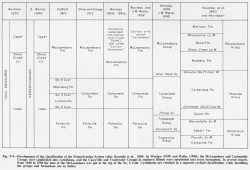Kewanee Group
Lithostratigraphy: Kewanee Group
Chronostratigraphy: Paleozoic Erathem >>Pennsylvanian Subsystem >>Desmoinesian Series
Allostratigraphy: Absaroka Sequence
Primary source
Willman, H. B., Elwood Atherton, T. C. Buschbach, Charles Collinson, John C. Frye, M. E. Hopkins, Jerry A. Lineback, and Jack A. Simon, 1975, Handbook of Illinois Stratigraphy: Illinois State Geological Survey Bulletin 95, 261 p.
Contributing author(s)
M. E. Hopkins and J. A. Simon
Name
Original description
The Kewanee Group (Kosanke et al., 1960, p. 31).
Derivation
Named for Kewanee, Henry County.
Other names
History/background
Type section
Type location
Type author(s)
Type status
Reference section
Reference location
Reference author(s)
Reference status
Stratigraphic relationships
Kewanee, in western Illinois, is in the outcrop belt of its two formations - Spoon and Carbondale (fig. P-2). It includes strata previously classified as the Carbondale Formation or Group plus older and younger strata (fig. P-5). The Kewanee Group is continuously recognized in all of the Illinois Basin within the confines of its outcrop limits. It normally lies above the Abbott Formation, but in northern and northeastern Illinois where the Abbott is missing it lies on rocks ranging in age from Valmeyeran (middle Mississippian) to Champlainian (middle Ordovician). It is overlain by the McLeansboro Group.
Extent and thickness
Lithology
The Kewanee Group contains the best developed cyclothems and more than 99 percent of the mapped coal reserves of the state (Cady et al., 1952). Lateral continuity of many of the lithologic units, especially the marine limestones, black fissile shales, coals, and underclays is remarkably extensive. The limestones, generally less than 5 feet thick, were deposited during marine transgressions from the west and southwest. Along with marine shales they alternate with fluvial and deltaic sediments that include siltstones, silty shales, elongate "channel" sandstones, and coals. The limestones are usually gray and argillaceous, and they contain a diverse marine fauna dominated by brachiopods, gastropods, crinoids, pelecypods, and Foraminifera (including fusulinids). The sandstones are texturally and mineralogically less mature than those of the McCormick Group in that they contain much more clay matrix, mica flakes, and feldspar grains, and their sand grains are less rounded and not as well sorted.
Core(s)
Photograph(s)
Contacts
Well log characteristics
Fossils
Age and correlation
Environments of deposition
Economic importance
Remarks
References
References
CADY, G. H., et al., 1952, Minable coal reserves of Illinois: Illinois State Geological Survey Bulletin 78, 138 p.
KOSANKE, R. M., J. A. SIMON, H. R. WANLESS, and H. B. WILLMAN, 1960, Classification of the Pennsylvanian strata of Illinois: Illinois State Geological Survey Report of Investigations 214, 84 p.
ISGS Codes
| Stratigraphic Code | Geo Unit Designation |
|---|---|

